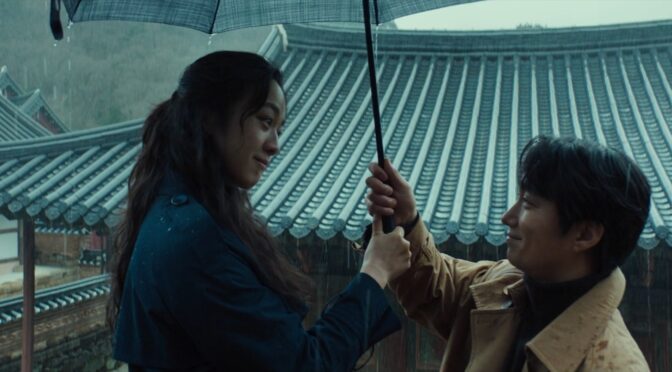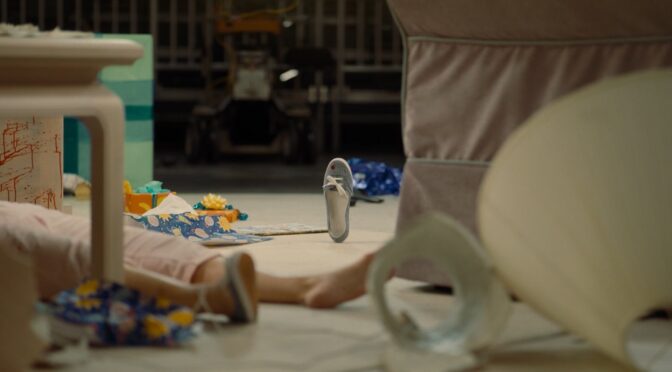

Maybe it’s residual annoyance at her Oscar snub but I feel like starting this review with a nice, buttery hot take. I think I just might consider General Nanisca in The Woman King to be EGOT-winner Viola Davis’ best screen performance. Perhaps some Davis performances have loftier literary credentials (Doubt, Fences, Ma Rainey’s Black Bottom). If her trademark volcanic intensity is what does it for you, maybe there have been times where she has quaked with more turmoil, when her hurricane force tears (and other more nasal-adjacent fluids) have rained down with more ferocity. Or times where she’s gotten more creative at applying her versatility to pulpy trash (Suicide Squad or, ahem, The Help). But Viola Davis’ work in Gina Prince-Bythewood’s lusciously mainstream African period piece is the one that I could wolf down a whole bowl of any time. I feel similarly about her work as Nanisca as I do about Russell Crowe’s irresistibly fun work as Ben Wade in 3:10 To Yuma. I feel about Viola Davis the way I feel about my favorite actor Paul Newman in many of his roles. In cases like these, the subtle character actor is unafraid to become a dynamic, show-stopping entertainer, and they manage to do it without sacrificing an ounce of their potent subtlety. It’s fun to watch actors this perfectly dialed in get saucy, fun roles like these because you can trust them to not go too big (a fact that puts this Davis performance full leagues above her work in Ma Rainey’s Black Bottom). Performances like this are arguments for how we might build a better star system. I don’t mean to glibly wave away the fears that movie stars are going away; that the nature of mega-stardom is changing or losing some of its draw with audiences. But I just cannot watch any ten minutes of The Woman King and not feel a little puzzled at the idea of the big, dynamic movie star being a dying breed. Here is a 57-year old woman playing a dramatic action role and utterly igniting the screen. While playing a character you have probably never heard of, no less. Yes, the nature of who can anchor a popular blockbuster film may be in flux. But 2022 made one thing abundantly clear to me. Viola Davis is a big old movie star.
Continue reading →


Rumors of the visual motif’s demise have been greatly exaggerated. If 2022 is anything to go off of, we can hopefully expect to see the explosive resurgence of symbolic visual patterns that bring added meaning to a film’s themes and just give directors more fun imagery to play with. It may be rare that a motif absolutely makes a film but, like extra containers of parmesan and red pepper with your pizza, who would ever claim a film is better off without them? The past year gave us a couple of great visual motifs, both of which made use of elemental imagery. In S.S. Rajamouli’s game-changing RRR, the exciting Indian director used the contrasting elements of fire and water to represent two characters’ opposition and testy bond and, of course, to produce some absolutely astounding cinematic imagery. The year’s other great elemental motif came from South Korean gonzo maestro Park Chan-wook’s Decision To Leave. The Handmaiden director’s latest stylistically audacious, overwhelmingly romantic extravaganza’s spellbinding denouement features a dazzling and suspenseful motif of earth and water that does everything a visual motif should do. It speaks to the film’s themes. It burrows into the frenzied, lovelorn psyches of its leads. And it gives Park Chan-wook a way of ending on a profoundly unshakable crescendo of pure visual splendor. A poorly thought-out motif can occasionally feel amateurish or like its compensating for a lack of theme (okay, I promise to go a full ten reviews without critiquing The Revenant again), but great motifs take theme and harmonize over it in ineffably stirring ways. They make ideas more cinematic and some would say that is the most important thing a film can do. In the case of Decision To Leave, a film I found not simplistic but ideologically stripped down, the use of a diverse array of visual, elemental signifiers is part of what truly makes the film vibrate on its own singularly powerful wavelength. They should have sent an opera lover to write this review. It’s not that I don’t think Decision To Leave is a gorgeous, juicy piece of writing. It really is. But it’s a film that hits emotional highs and lows that are much better felt and seen than carefully corralled into words. Park Chan-wook’s latest disorienting feast is a deliriously rapturous and pained ode to the kind of love and obsession that turns us into sub-verbal animal versions of ourselves. Its terrific literate murder mystery is really just setting the table for a baser, more elemental mystery about human emotion. It’s a detective story about feelings so deep within our guts that words can’t even hope to reach them.
Continue reading →


I would like to start my first review of the spellbinding 2022 cinema crop with a very heartfelt apology to estimable octogenarian Polish director Jerzy Skolimowski and the six very talented donkeys who starred in his lovely, wise and animal-loving late career triumph EO. I had it sitting at number 20 with my list seemingly finalized. I was eager to watch the film again and offer up my thoughts on that astonishing, relatively wordless gem. But I’m afraid that, at the absolute 11th hour, the fates came sprinting down the hall with a last minute fax from top brass (quite the lively, Aaron Sorkian office this cinema-addled brain is!). Top 20 placement for EO was to be a reluctant, well, nope. While showing a close friend the latest David Ehrlich film countdown video, we turned to the subject of Jordan Peele’s Nope, which he had recently seen. In explaining why I had increasingly come to love it the more I sat with it, I began going into its teeming ideas and how they all mingled together or maybe didn’t. And as we parsed through them, I had a sudden epiphany about the fearsome sky predator that stalks our main cast throughout the film and how much dread Jordan Peele milks out of its nebulous shape. And that’s before we even see its shape. At first it’s just a blur, obscured by night or by cloud cover. “It’s scary how hard the creature is to pin down and describe,” my friend noted. “Right,” I replied before it suddenly hit me. “But then the Haywood siblings do find a way to describe him. They name him. He’s Jean Jacket.” I realized that, among Peele’s many insights on what scares us, he had subtly made a comment on how giving a name to something that feels beyond description and comprehension helps us reduce our fear of it. Sure, the creature is still an enormously terrifying threat, capable of eating a bleacher’s worth of people in barely an instant. But it also looks a lot like an unfolded denim jacket at one point (when it’s not looking like a big cowboy hat). And we can now laugh at the thing that frightens us. This was the moment I knew Nope had to be included in this countdown. A film so chock full of rich psychological ideas that it was still spitting new ones out at me all these months later just could not be denied. At this point, I’ll assume I’ve barely scratched the surface and that the next time I watch it a few more insights will tumble out of it. Like forgotten quarters out of an old jean jacket.

Continue reading →
Home of Carnivorous Couch: A film a week from two film geeks.







